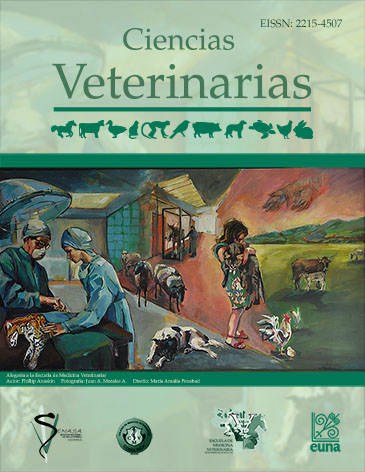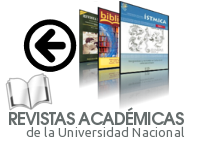Comportamiento reproductivo del ácaro Varroa destructor (Mesostigmata: Varroidae) en celdas con cría de obrera y zángano en abejas africanizadas (Apis mellifera) en condiciones tropicales
DOI:
https://doi.org/10.15359/rcv.37-2.5Palabras clave:
Varroa destructor, abejas africanizadas, comportamiento reproductivo, cría de obrera, cría de zánganoResumen
Se estudió el comportamiento reproductivo del ácaro Varroa destructor en celdas con cría de obrera y zángano, durante el período de enero a agosto. Se utilizó 10 colmenas de abejas africanizadas (A. mellifera), ubicadas en el Centro de Investigaciones Apícolas Tropicales (CINAT), Lagunilla de Heredia, Costa Rica. La investigación se dividió en dos fases: a) la infestación artificial con el ácaro varroa de celdas con cría de obrera (n= 732) y b) la infestación artificial de celdas con cría de zángano con los ácaros provenientes de las celdas de obrera (n= 362). Además, se comparó la habilidad reproductiva de varroa en ambos tipos de celda (n= 362), y se analizó en detalle los ácaros que no se reprodujeron en la cría de obrera y que fueron transferidos a la cría de zángano (n= 85). Las celdas se revisaron 10 días después de infestadas artificialmente. Se evaluaron los siguientes parámetros reproductivos para cada ácaro: fertilidad, fecundidad, producción de hijas fértiles, producción de cría inmadura, producción de únicamente hembras, únicamente macho y no reproducción. En cría de obrera la fertilidad de varroa fue de un 76.9%; sin embargo, solo el 16.5% de los ácaros produjo hijas fértiles, con un promedio de 1.3 ± 0.5 hijas fértiles. Mientras que, en cría de zángano, la fertilidad fue de un 79.3% y un 38.1% de los ácaros produjo hijas fértiles, con un promedio de 2.1 ± 0.9 hijas viables por celda. Al comparar la habilidad reproductiva de varroa se encontró que la fertilidad fue similar en ambos tipos de cría, no obstante, en celdas con cría de zángano una cantidad considerable de ácaros produjo hijas fértiles, mientras que en celdas de obrera se encontró únicamente un 13.8%. Además, la producción de cría inmadura fue significativamente mayor en celdas con cría de obrera, superando el 40.0%. Uno de los resultados más relevantes fue que el 74.1% de los ácaros que no tuvieron reproducción en la cría de obrera, se reprodujeron después de ser transferidos a celdas con cría de zángano, indicando que este tipo de cría es esencial para el desarrollo y crecimiento de la población del ácaro V. destructor en colmenas de abejas africanizadas bajo condiciones tropicales.
Referencias
Beetsma, J., Boot, W.J. & Calis, J. 1999. Invasion behaviour of Varroa jacobsoni Oud: from bees into brood cells. Apidologie 30(2-3): 125-140. Doi: 10.1051/apido:19990204
Boot, W.J., Schoenmaker, J., Calis, J. & Beetsma, J. 1995a. Invasion of Varroa jacobsoni into drone brood cells of honey bee, Apis mellifera. Apidologie 26(2): 109-118. Doi: 10.1051/apido:19950204
Boot, W.J., Van Baalen, M. & Sabelis, M.W. 1995b. Why do Varroa mites invade worker brood of the honey bee despite lower reproductive success? Behav. Ecol. Sociobiol. 36(4): 283-289. Doi: 10.1007/BF00165837
Calderón, R.A., Sommeijer, M.J., de Ruijter, A. & van Veen, J.W. 2003a. The reproductive ability of Varroa destructor in worker brood of Africanized and hybrid honey bees in Costa Rica. J. Apicult. Res. 42(4): 65-67. Doi: 10.1080/00218839.2003.11101095.
Calderón, R.A., van Veen, J., Arce, H.G. & Esquivel, M. 2003b. Presence of deformed wing and Kashmir bee virus in Africanized honey bee colonies in Costa Rica infested with Varroa destructor. Bee World 84(3): 112-116. Doi: 10.1080/0005772X.2003.11099586.
Calderone, N.W. & Kuenen, L.P.S. 2003. Differential tending of worker and drone larvae of the honey bee, Apis mellifera, during the 60 hours prior to cell capping. Apidologie 34: 543-552. Doi: 10.1051/apido:2003054.
Calis, J.N.M., Boot, W.J., Beetsma, J., van den Eijnde, J.H., de Ruijter, A. & van der Steen, J.J.M. 1999. Effective biotechnical control of varroa: applying knowledge on brood cell invasion to trap honey bee parasites in drone brood. J. Apicult. Res. 38(1-2): 49-61. Doi: 10.1080/00218839.1999.11100995.
Calis, J.N.M. 2001. Parasite-host interaction between the varroa mite and the honey bee: A contribution to sustainable varroa control. Master Thesis. Wageningen University. NL. p. 55-60.
Camazine, S. 1986. Differential reproduction of the mite, Varroa jacobsoni (Mesostigmata:Varroidae), on Africanized and European honey bees (Hymenoptera:Apidae). Ann. Entomol. Soc. Am. 79(5): 801-803. Doi: 10.1093/aesa/79.5.801.
Clarke, G.M. 1989. Statistics and experimental design. 2nd Edition. Edward Arnold, Newcastle, U.K. p. 28-30.
Contzen, C., Garedew, A., Lamprecht, I. & Schmolz, E. 2004. Calorimetrical and biochemical investigations on the influence of the parasitic mite Varroa destructor on the development of honeybee brood.
Thermochim. Acta 415(1-2): 115-121. Doi: 10.1016/j.tca.2003.06.006
Corrêa-Marques, M.H., Medina, L., Martin, S.J. & De Jong, D. 2003. Comparing data on the reproduction of Varroa destructor. Genet. Mol. Res. 2(1): 1-6.
De Guzmán, L., Rinderer, T.E., Collins, A. & Lancaster, V.A. 2001. Attractiveness of Africanized honey bee brood from Southern Texas to Varroa destructor infestation. Am. Bee J. 142(2): 130-132.
De Jong, D. 1997. Mites: Varroa and other parasites of brood. In Morse, R.A. & Flottum, K. (Eds.). Honey bee pests, predators, and diseases, 3rd Edition. A.I. Root Company, Ohio. p. 281-327.
De Ruijter, A. 1987. Reproduction of Varroa jacobsoni during successive brood cycles of the honeybee. Apidologie 18(4): 321-326. Doi: 10.1051/apido:19870403.
De Ruijter, A. & Pappas, N. 1983. Karyotype and sex determination of Varroa jacobsoni Oud. In Cavalloro, R. (Ed.). Varroa jacobsoni Oud. affecting honeybees: present status and needs. University of Wageningen, NL. p. 41-44.
Garrido, C., Rosenkranz, P., Paxton, R.J. & Gonçalves, L.S. 2003. Temporal changes in Varroa destructor fertility and haplotype in Brazil. Apidologie 34(6): 535-541. Doi: 10.1051/apido:2003041.
Al-Ghamdi, A. & Hoopingarner, R. 2003. Reproductive biology of Varroa jacobsoni Oud. in worker and drone brood of the honey bee Apis mellifera L. under Michigan conditions. Pak. J. Biol. Sci. 6(8): 756-761. Doi: 10.3923/pjbs.2003.756.761.
Hrassnigg, N. & Crailsheim, K. 2005. Differences in drone and worker physiology in honeybees (Apis mellifera). Apidologie 36: 255-277. Doi: 10.1051/apido:2005015.
Ifantidis, M.D. 1983. Ontogenesis of the mite Varroa jacobsoni in worker and drone honeybee brood cells. J. Apicult. Res. 22(3): 200-206. Doi: 10.1080/00218839.1983.11100588.
Martin, S.J. 1995a. Ontogenesis of the mite Varroa jacobsoni Oud. in worker brood of the honeybee Apis mellifera L. under natural conditions. Exp. Appl. Acarol. 19(4): 199-210. Doi: 10.1007/BF00130823
Martin, S.J. 1995b. Reproduction of Varroa jacobsoni in cells of Apis mellifera containing one or more mother mites and the distribution of these cells. J. Apicult. Res. 34(4): 187-196. Doi: 10.1080/00218839.1995.11100904.
Martin, S.J. & Kemp, D. 1997. Average number of reproductive cycles performed by Varroa jacobsoni in honey bee (Apis mellifera) colonies. J. Apicult. Res. 36(3-4): 113-123. Doi: 10.1080/00218839.1997.11100937.
Martin, S.J., Holland, K. & Murray, M. 1997. Non-reproduction in the honeybee mite Varroa jacobsoni. Exp. Appl. Acarol. 21(8): 539-549.
Martin, S.J. & Kryger, P. 2002. Reproduction of Varroa destructor in South African honey bees: does cell space influence Varroa male survivorship? Apidologie 33(1): 51-61. Doi: 10.1051/apido:2001007.
Martin, S.J. & Medina, L.M. 2004. Africanized honeybees have a unique tolerance to Varroa mites. Trends Parasitol. 20(3): 112-114. Doi: 10.1016/j.pt.2004.01.001.
Medina, L.M. & Martin, S.J. 1999. A comparative study of Varroa jacobsoni reproduction in worker cells of honey bees (Apis mellifera) in England and Africanized bees in Yucatan, Mexico. Exp. Appl. Acarol. 23(8): 659-667. Doi: 10.1023/A:1006275525463
Medina, L.M., Martin, S.J., Espinosa-Montaño, L. & Ratnieks, F.L.W. 2002. Reproduction of Varroa destructor in worker brood of Africanized honey bees (Apis mellifera). Exp. Appl. Acarol. 27(1-2): 79-88. Doi: 10.1023/A:1021579113907
Moretto, G.A., Pillati, A., De Jong, D., Gonçalves, L.S. & Cassini, F.L. 1995. Reduction of varroa infestation in the state of Santa Catarina, in Southern Brazil. Am. Bee J. 6: 498-499.
Moretto, G., Gonçalves, L. & De Jong, D. 1997. Relationship between food availability and the reproductive ability of the mite Varroa jacobsoni in Africanized bee colonies. Am. Bee J. 137(1): 67-69.
Ravazzi, G. 1995. Curso de Apicultura, 2nd Edition. De Vecchi S.A., Barcelona. p. 70-71.
Rosenkranz, P. 1999. Honey bee (Apis mellifera L.) tolerance to Varroa jacobsoni Oud. in South America. Apidologie 30(2-3): 159-172. Doi: 10.1051/apido:19990206
Schneider, S., DeGrandi-Hoffman, G. & Smith, D.R. 2004. The African honey bee: factors contributing to a successful biological invasion. Annu. Rev. Entomol. 49: 351-376. Doi: 10.1146/annurev.ento.49.061802.123359.
Vandame, R., Colin, M.E., Morand, S. & Otero-Colina, G. 2000. Levels of compatibility in a new host-parasite association: Apis mellifera/Varroa jacobsoni. Can. J. Zool. 78(11): 2037-2044. Doi: 10.1139/cjz-78-11-2037.
Wilkinson, D. & Smith, G.C. 2002. Modelling the efficiency of sampling and trapping Varroa destructor in the drone brood of honey bees (Apis mellifera). Am. Bee J. 142(3): 209-212.
Descargas
Publicado
Cómo citar
Número
Sección
Licencia
Licenciamiento de los artículos
Todo artículo se publicará con una licencia:

Licencia Creative Commons Atribución-NoComercial-SinDerivadas 3.0 Costa Rica.
El acceso a esta revista es gratuito, solo se debe citar en forma completa el artículo y la revista.
Los derechos de propiedad intelectual son del autor. Una vez aceptado el artículo para su publicación el autor cede a la Revista los derechos de reproducción.
La Revista de Ciencias Veterinarias autoriza la impresión de artículos y fotocopias para uso personal. También, se promueve el uso para fines educacionales. Especialmente: instituciones podrán crear enlaces a artículos específicos que se encuentren en el servidor de la revista a fin de conformar paquetes de cursos, seminarios o como material de instrucción.
El autor puede colocar una copia de la versión definitiva en su servidor aunque se recomienda que mantenga un enlace al servidor de la revista donde está el artículo original.
Las violaciones de propiedad intelectual recaen sobre quien la realizó. No es responsable la empresa o institución que da acceso a los contenidos, ya sea porque actúa sólo como transmisora de información (por ejemplo, proveedores de acceso a Internet) o porque ofrece servicios públicos de servidores.







